Director Kitano Presents on JICA’s Efforts in Africa at the Shanghai Conference on Africa and Asia
2017.12.11
The Shanghai Conference on Africa and Asia: "Africa-Asia Connections: Bridging Past, Present and Future” was held on Nov. 16 and 17, 2017 in Shanghai, China. It was hosted by the Harvard University Center for African Studies, and co-organized by the Fairbank Center for Chinese Studies, Harvard University Asia Center, the East Asian Legal Studies Program. It consisted of keynote speeches and six panel sessions. Naohiro Kitano, Director of the JICA Research Institute (JICA-RI), presented in panel one and six, and Suguru Miyazaki, senior representative of the JICA China Office, participated as a chair in panel two, on “Infrastructure, Trade and Industry.”
The Shanghai Conference was established to facilitate dialogue between academics, policy makers, and those in the private sector. Approximately 50 people from these fields gathered to discuss issues related to the three central themes: “Migration, Aid and Trade,” “Environment, Science, Infrastructure and Industry” and “Partnerships in Public Health.”

Director Kitano spoke at panel six(Photo provided by the Harvard University Center for African Studies)
Kitano participated in panel one, “Broad Perspectives: India, Japan and China in Africa” as a discussant. In discussing Japan’s development efforts in Africa, he stressed that the process of 2016 Tokyo International Conference on African Development (TICAD) was open and inclusive, and spoke on JICA’s new Initiative for Food and Nutrition Security in Africa (IFNA).
In panel six, “Africa and Asia: The Way Forward,” Kitano spoke on the characteristics of JICA’s efforts in facilitating the development of Africa, based on the three pillars of the Nairobi Declaration established at TICAD VI: Pillar 1 - Promoting structural economic transformation through economic diversification and industrialization, Pillar 2 - promoting resilient health systems for quality of life and Pillar 3 - promoting social stability for shared prosperity. He spoke about how these efforts are to handle the issues facing Africa today.
Kitano gave several examples of how JICA has contributed to Pillar 1. He referred to Olkaria geothermal power project in Kenya and the development of master plans to develop economic corridors as examples of quality infrastructure, and the Ajinomoto “Ghana Nutrition Improvement Project” as an example of JICA cooperating with the private sector. He also spoke on JICA’s support of the Jomo Kenyatta University of Agriculture and Technology since 1978, as an example of a long-term effort to build a mutual relationship between Japan and Africa. As examples of the scaling-up approach, he introduced the Africa KAIZEN Initiative, based on the Japanese business management method of “kaizen.” He also spoke of the Small-Holder Horticulture Empowerment and Promotion (SHEP) approach. The SHEP approach addresses the motivation of farmers, and ensures their success in farming as a business. This approach was originally developed in Kenya and since then spread to 23 other African countries.

Kitano introduced Japan's development efforts in Africa(Photo provided by the Harvard University Center for African Studies)
Kitano discussed many of JICA’s diverse projects. With regards to Pillar 2, he spoke of a development policy that lends for the purposes of supporting Kenyan health care, as an example of Universal Health Coverage (UHC)—providing health services to all people. For Pillar 3, he gave as an example the Coalition for African Rice Development (CARD) initiative, an evidence-based approach that aims to solve food shortage, and how the JICA-RI conducts impact analyses for this approach.
Finally, Kitano spoke on JICA’s new vision, “Leading the world with trust,” and emphasized the importance of a mutual trust with Africa. The audience then asked questions on the definition of quality infrastructure, and the reality of working with NGOs in Africa. This valuable discussion allowed participants to think about the relationship between Japan, Asia and Africa.

事業事前評価表(地球規模課題対応国際科学技術協力(SATREPS)).国際協力機構 地球環境部 . 防災第一チーム. 1.案件名.国 名: フィリピン共和国.

事業事前評価表(地球規模課題対応国際科学技術協力(SATREPS)).国際協力機構 地球環境部 . 防災第一チーム. 1.案件名.国 名: フィリピン共和国.

事業事前評価表(地球規模課題対応国際科学技術協力(SATREPS)).国際協力機構 地球環境部 . 防災第一チーム. 1.案件名.国 名: フィリピン共和国.

事業事前評価表(地球規模課題対応国際科学技術協力(SATREPS)).国際協力機構 地球環境部 . 防災第一チーム. 1.案件名.国 名: フィリピン共和国.

事業事前評価表(地球規模課題対応国際科学技術協力(SATREPS)).国際協力機構 地球環境部 . 防災第一チーム. 1.案件名.国 名: フィリピン共和国.
scroll